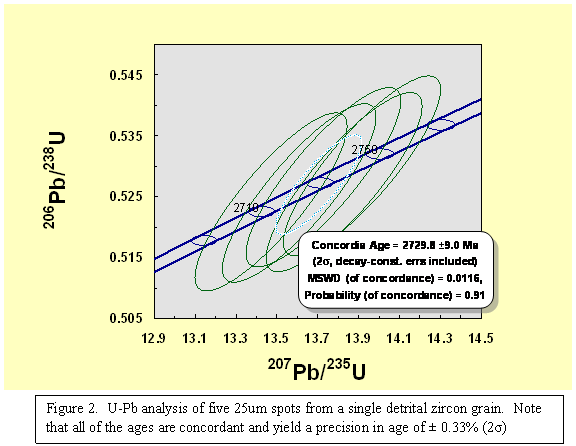

45112-G8
U-Pb Age and Hf Isotope Composition of Detrital Zircons from Strata of the Ouachita Orogenic Belt, Arkansas, Oklahoma, and Texas
This research aims to constrain the source of allochthonous slope and rise sediments as well as flysch from the Ouachita Mountains in Arkansas and Oklahoma and the Marathon Uplift in southwest Texas. The rocks from these two locations provide a nearly complete stratigraphic record from Cambrian to Late Carboniferous. Within this record, a continent wide shift in sediment provenance around 450 Ma is recorded in both the Ouachita Mountains and Marathon Uplift (Patchett et al., 1999, Science, V283, p. 671-673), and this change in provenance is characterized by a sharp shift in Nd isotope composition (Gleason et al., 1995, GSA Bulletin, 107, 1192-1210). Although Nd isotopes can place general constraints on average sediment source age, specific source regions (e.g., Proterozoic vs. Archean craton) as well as relative mixing proportions of sediment derived from variable age sources cannot be resolved by Nd isotopes alone. This research proposes to use zircon, which is an extremely durable mineral in sedimentary environments, to better understand sediment sources and their relative contributions to the Ouachita embayment. The use of detrital zircons to solve this problem is attractive because they retain a record of source age as well as source lithology (e.g., evolved versus juvenile crust based on Hf isotope compositions) enabling better correlations between ultimate sediment sources and sinks as well as better constraints on sediment mixing prior to deposition in the Ouachita and Marathon regions.
SHAPE \* MERGEFORMAT We continue to analyze samples (we received a no-cost
extension to this proposal) and process through the data. Barry Shaulis is
also comparing the grain shape and size if detrital
zircons in an effort to understand if some populations of grains may be derived
from primary or recycled sources.
Basically, we are correlating mineral roundness with our measured ages
in an effort to correlate age to degree of transport/recycling. It is important to note that we are also
taking into consideration the U and Th content of
these rounded grains so that radiation damage can be assessed in terms of
abrasion characteristics. Whenever
possible, we are analyzing the same grain more than once to assess whether the
grain has been closed to U and Pb gain or loss after
formation and to gather information of the ages of Pb
loss due to thermal events (metamorphism) using the principle of U-Pb age concordance.
In some grains, we are able to determine upper and low intercept ages
(from a single grain!) on concordia (formation and
subsequent metamorphism), thus making our provenance criteria more robust. Data collection is ongoing and Barry Shaulis is making excellent progress on his MS thesis. Development of the laser-ablation mass spectrometry
methods at the University of Houston has been one of the most important and
time-consuming steps of this investigation.
We have spent most of the winter 2006 through Spring
of 2008 analyzing standard and unknown zircons and have made improvements to
the methods throughout. A very large hurdle has been developing a robust method
for common lead corrections, an important analytical detail for accurate age
determinations. We have made significant
advancements but we will continue to improve on this method for years to
come. The results of our development
work indicate that we are able to measure the age of individual zircons with
excellent precision and accuracy (Figure 2), which approaches that of expensive
and time-intensive ionprobe techniques. Our work on the Hf
isotope compositions of zircons will continue into the summer of 2009. SHAPE \* MERGEFORMAT
 The primary efforts of myself, graduate student Barry Shaulis,
and undergraduate student Darshan Ghandi in the second 12 months of this research has
been in the characterization, processing and analysis of roughly 20 representative
samples spanning Cambrian to Mississippian time in parallel with development and
refinement of laser ablation mass spectrometry methods at UH. As of writing this statement, we continue to
analyze our samples by LA-ICPMS and analyze the data. Based on our results so far, we observe some
important features in the zircon record.
Figure 1 represents zircon age spectra from two units, the Pennsylvanian
Jackfork Sandstone and the Ordovician Blakely
Sandstone. These units represent the
youngest and oldest rocks we have from the Ouachita Mountains. Some key features are the presence of
detritus from Gondwana (interpreted to be derived
from Yucatan basement rocks). We also
see the emergence of material that is likely derived (or recycled) from Appalachian
mobile belts in the Jackfork, including material from
the Yavapi-Mazatzal Province. Archean-aged detritus is also likely to be
directly derived from reworked Appalachian basins.
The primary efforts of myself, graduate student Barry Shaulis,
and undergraduate student Darshan Ghandi in the second 12 months of this research has
been in the characterization, processing and analysis of roughly 20 representative
samples spanning Cambrian to Mississippian time in parallel with development and
refinement of laser ablation mass spectrometry methods at UH. As of writing this statement, we continue to
analyze our samples by LA-ICPMS and analyze the data. Based on our results so far, we observe some
important features in the zircon record.
Figure 1 represents zircon age spectra from two units, the Pennsylvanian
Jackfork Sandstone and the Ordovician Blakely
Sandstone. These units represent the
youngest and oldest rocks we have from the Ouachita Mountains. Some key features are the presence of
detritus from Gondwana (interpreted to be derived
from Yucatan basement rocks). We also
see the emergence of material that is likely derived (or recycled) from Appalachian
mobile belts in the Jackfork, including material from
the Yavapi-Mazatzal Province. Archean-aged detritus is also likely to be
directly derived from reworked Appalachian basins.
